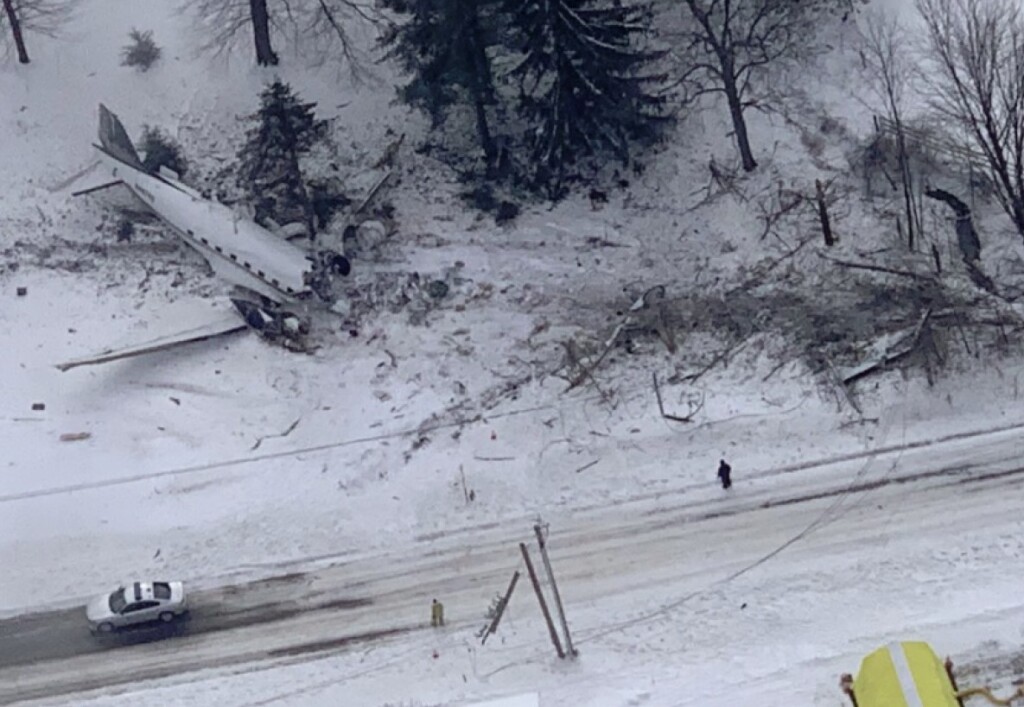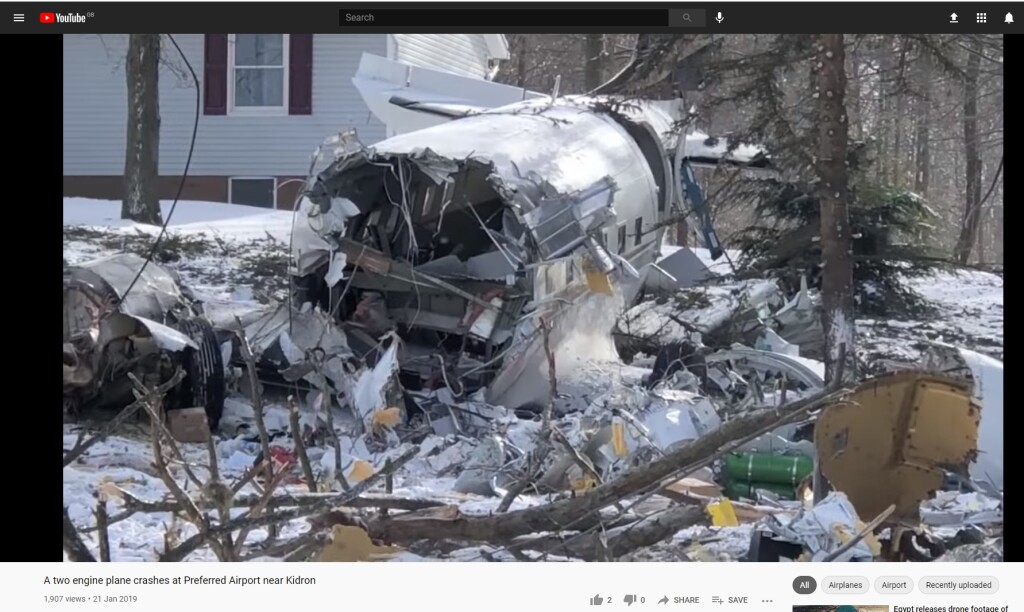Fatal 2019 DC-3 Turbo Prop Accident, Positioning for FAA Flight Test: Power Loss Plus Failure to Feather (N467KS)
On 21 January 2019 a 1944 Douglas DC-3C-65TP, N467KS, owned by Priority Air Cargo and operated by AFM Hardware, was involved in a take-off accident in Kidron, Ohio. Both pilots onboard were fatally injured.
The Accident Flight
The US National Transportation Safety Board (NTSB) explain in their safety investigation report (issued in November 2020) that the aircraft…
…was the prototype for an Amended Supplemental Type Certificate (STC) project to add newer model Pratt and Whitney Canada (P&WC) PT6A[-67F] series engines and MT propellers to the existing STC.
Flight Manual extracts in the public docket suggest this was the ‘Preferred Turbine -3‘ STC.
The airplane was issued an experimental airworthiness certificate on July 27, 2018. Following several project meetings with the Federal Aviation Administration (FAA), certification and flight test plans were created.
On the day of the accident:
The airplane was loaded with ballast to maximum gross weight and was being positioned from Stoltzfus Airfield (OH22), Kidron, Ohio, to Akron Canton Regional Airport (CAK), North Canton, Ohio, to pick up a FAA test pilot for initial flight testing of stall maneuvers.
The aircraft commander, who appears to have been the Pilot Flying, was 55 and had 15457 flying hours experience, 5612 on type. He was DC-3TP Part 125 check airman and was the chief pilot for AFM Hardware. This was his eighth flight in the aircraft since the PT6As were fitted. The co-pilot was 56 and had 9969 flying hours experience, 12 on type and this was his fourth flight in this aircraft with PT6As installed.
The cockpit voice recorder (CVR) began recording before takeoff, about 0902.
Crucially:
According to the recording, the captain elected to forego the auto-feather system and overspeed governor tests that were listed in the “run up” section of the normal checklist because of the snow packed conditions on the taxiway and runway.
As the captain was completing the before takeoff checklist, he stated all four boost pumps were on and all annunciator panel lights were extinguished. The captain briefed the takeoff decision speed (V1), rotation speed (Vr) and climb speed (V2) of 82, 84, and 90 knots respectively.
Soon after liftoff [at 0911:27] and about 3 seconds after decision speed (V1), the left engine lost total power. The propeller began to auto-feather but stopped feathering about 3 seconds after the power loss.
Witnesses observed white smoke exiting the left engine exhaust system immediately after takeoff and the airplane banked and yawed left.
At 0911:35 and 0911:39, the captain made brief comments that indicated he was struggling to fly the airplane. The airplane yawed and banked to the left, descended, and… struck power lines and trees before impacting terrain [at 0911:40].
The airplane came to rest about 600 ft from the end of runway 19 and about 700 ft to the left of the runway centerline. The main wreckage was upright and oriented on a northwesterly heading, with the fuselage separated forward of the wings.
NTSB Safety Investigation
Downloaded automated data acquisition system (ADAS) data indicated left engine torque, fuel flow, gas generator speed (Ng), propeller rpm (Np) rapidly decreased at 0911:26.5. At 0911:27.2, left engine torque dropped to nearly zero and Ng decreased until the end of the recorded data. Left engine Np dropped to 746 rpm at 0911:30, then increased to 1050 rpm about 4 seconds later. Airspeed reached a maximum of 91 knots at 09:11:31.
Recorded engine data indicated the power loss was due to an engine flameout; however, examination of the engine did not determine a reason for the flameout or the auto-feather system interruption.
It is estimated that the minimum airspeed required to maintain lateral control after an engine failure with an unfeathered propeller was between 97 and 107 knots. Recorded data showed the engine failure occurred at about 86 knots and the aircraft only reached a maximum of about 91 knots.
By the end of recorded data at 0911:41, Np and airspeed had decreased to 971 rpm and 73 knots, respectively.
The checklist for an engine failure at take-off is below. Items in bold are memory items.
NTSB Probable Cause and Analysis
The NTSB state the probable cause as:
The loss of airplane control after an engine flameout and auto-feather system interruption during the takeoff climb, which resulted in an impact with terrain.
The NTSB were unable to determine the cause of either the flameout or the failure to auto-feather they did state in their analysis:
While it is plausible that an air pocket developed in the fuel system during the refueling just before the flight, this scenario was not able to be tested or confirmed.
It is possible that the auto-feather system interruption would have occurred if the left power lever was manually retarded during the auto-feather sequence.
NTSB state:
The power loss and auto-feather system interruption occurred during a critical, time-sensitive phase of flight…[and] would have challenged the pilots’ ability to manually feather the propeller quickly and accurately.
Additionally:
The flight manual did not specify position of the ignition switch for normal takeoff. Following the accident, the operator updated the flight manual to require both engine ignition systems be switched to manual before takeoff to ensure continuous ignition.
Safety Resources
You may also find these Aerossurance articles of interest:
- British Midland Boeing 737-400 G-OBME Fatal Accident, Kegworth 8 January 1989
- AAIB: Human Factors and the Identification of Saab 2000 Flight Control Malfunctions
- Procedural Drift at Saab 340 Operator Leads to Taxiway Excursion
- Improvised Troubleshooting After Cascading A330 Avionics Problems
- Challenge Assumptions: ATSB on A330 with a u/s GPS
- Gulfstream G-IV Take Off Accident & Human Factors
- Confusion of Compelling, But Erroneous, PC-12 Synthetic Vision Display
- ATR 72 In-Flight Pitch Disconnect and Structural Failure
- C-130J Control Restriction Accident, Jalalabad
- B777 in Autoland Mode Left Runway When Another Aircraft Interfered With the Localiser Signal
- Distracted B1900C Wheels Up Landing in the Bahamas
- HF Lessons from an AS365N3+ Gear Up Landing
- B737 Speed Decay, Automation and Distraction
- Aborted Take Off with Brakes Partially On Results in Runway Excursion
- Easyjet A320 Flap / Landing Gear Mis-selections
- Wrong Engine Shutdown Crash: But You Won’t Guess Which!: BUA BAC One-Eleven G-ASJJ 14 January 1969
- Premature A319 Evacuation With Engines Running
- Runaway Dash 8 Q400 at Aberdeen after Miscommunication Over Chocks
- Misted Masks: AAIB A319 Report Reveals Oxygen Mask Lessons
- Investigators Suggest Cultural Indifference to Checklist Use a Factor in TAROM ATR42 Runway Excursion
- ANSV Highlight Procedures & HF After ATR72 Landing Accident
- Safety Lessons from TransAsia ATR-72 Flight GE222 CFIT
- Fuel System Maintenance Error: Tuniter ATR72 TS-LBB Ditching 6 August 2005
- Unalaska Saab 2000 Fatal Runway Excursion: PenAir N686PA 17 Oct 2019
- Cockpit Tensions and an Automated CFIT Accident
- Southwest Unstabilised Approach Accident
- Gust Lock Gaff: King Air A90 Runway Excursion
- A Saab 2000 Descended 900 ft Too Low on Approach to Billund
- Fatal US Helicopter Air Ambulance Accident: One Engine was Failing but Serviceable Engine Shutdown
- Culture + Non Compliance + Mechanical Failures = DC3 Accident
- UPDATE 4 August 2022: DC3-TP67 CFIT: Result-Oriented Subculture & SMS Shelfware






Recent Comments